Fellini, Bertolucci, Antonioni, Rossellini, Leone. Everyone listed here is a) an iconic and generally well-regarded Italian film director and b) absolutely not the subject of this blog entry.
Instead I’m going to look at a very different sort of Italian filmmaker and the films they made, none of which are likely being considered for their own Criterion Collection release any time soon. (One of my alternate title choices was Italian Movies: The Not Exactly Criterion Edition) I’m referring to the trend in Italian crime films from the late 1960 into the mid-70s called Poliziotteschi.
Before I jump in with a quick summary of Poliziotteschi for the few readers who aren’t already fans of these decades-old Euro-crime thrillers I should add that most of the films mentioned here are available for streaming on Kanopy through the library.
My love of Italian crime films did not fully bloom until fairly recently. A few years ago, I started bringing home some Italian made Westerns (aka Spaghetti Westerns) from the library’s movie collection. Once those were exhausted, it was followed by a steady flow of Italian crime films (Poliziotteschi) and Italian horror-mystery (Giallo) from the 1970s. Italian crime film directors of the day wore their influences on their sleeves. They watched American films such as Bullitt, The French Connection, The Godfather, Dirty Harry, Serpico and Death Wish and I assume thought to themselves “Why not us?”
The Italian film industry of the time seems to have never met a single mini-trend in popular cinema it didn’t try to exploit and make their own. With mixed results. American films provided the inspiration, Italian directors provided the formula: Watch, imitate, repeat (It’s a small feat of linguistic contortionism that I have avoided using “rip off” here) until some level of financial success followed. Once they had a hit, like a stunt driver in their films’ obligatory car chase scenes, they kept the pedal to the medal churning out film after film in a movie-making-mill. Each trend was ridden remorselessly hard until it was bled dry financially and creatively. However, the fact is, the creative teams behind these movies put their own wonderfully unique stamp on the films that weren’t found in their American counterparts.
The term Poliziotteschi refers to movies related to or involving police solving crime by old fashion detective work. Usually the crimes being investigated were familiar to urban Italians of the day: kidnapping, assassinations, extortion, bombing, mafia machinations, still more kidnapping (so much kidnapping!). The chaos depicted in these films reflected the day to day reality in many Italian cities in the 70s during what became known as The Anni di piombo or The Years of Lead. Terrorists (on the right and the left), Mafia and small-time criminals all clashed against one another trying to impose their will on society through violence, and intimidation. Toss in ineffective elites and politicians plus the police’s often overzealous attempts to install some degree of order and you have the percolating, bubbling hodge podge that is poliziotteschi.
If one was to draw up a storyboard for an Italian crime film here is how it could potentially go. An average law-abiding citizen or well-meaning cop has someone close to them killed or kidnapped by the amoral and sadistic bad guys. These killed or kidnapped characters seem to fulfill a similar role as Red Shirts in Star Trek – you just know they’re going to come to a bad end. After attempts at seeking justice go nowhere (so much red tape! So many bureaucratic hoops to jump through!) they must take matters into their own hands (vigilante style!) and cynically dispatch with the bad guys in no uncertain terms (translation: they’ll never live to see the inside of a courtroom)
But before the final squibs explode from the antagonist’s chest you’re likely to experience:
- A plot hole or two big enough to drive a ‘70s era tiny Fiat 500 through
- Ridiculously dangerous chase scene involving motorcycles / small cars going up and down massive sets of outdoor stairs causing no end of property damage in the process (fruit stand owners beware!)
- A rampant disregard for civilian life by all concerned: in a “we had to destroy the village in order to save it” kind of way, the ends justify the means (The apparent death of a few bystanders is but a small price to pay if it means one less purse snatcher on the street!)
- An odd result of being hemmed in by pesky police procedures and regulations is that ultimately no rules are followed. Physical Intimidation of informants and witnesses? (You betcha!) Not following the proper chain of custody for evidence (quit your nitpicking!) Using victims as bait? (what better way to draw out the gutter-dwellers?)
- An apoplectic police chief (watch the spittle fly!) who tries in vain to reign in the vigilante / police from their worst instincts (see the above two points)
- There is a good chance there will be a showdown / shootout / foot chase in some variety of empty industrial backdrop – an abandoned quarry or cardboard box factory for example – basically any location the producers didn’t need to lay down much cash for a shooting permit. In fact, I get the impression permits of any sort were an afterthought in many cases. Let’s just say Health & Safety legislation may not have been observed on set.
- You can’t talk Italian film making of the era without bringing up the strategic product placement of J & B scotch Whiskey. Trust me, once pointed out it is impossible not to notice. Although not from poliziotteschi, this supercut from 40 giallo films lays it all out in no uncertain terms.
- And lastly there is the music. But what music it was! The soundtracks are almost uniformly fantastic. Veering effortlessly between dynamic and driving funky grooves, chilled out easy listening, and lush romantic orchestration for those occasional love scenes sandwiched in between a torture scene and a stakeout. Even when the film itself does not have much to offer, these Italian composers and their spectacular instrumentals always manage to shine. To paraphrase The Dude in The Big Lebowski – the music really tied the genre together. If you’ve ever doubted that a flute solo could bring the heat, you may want a rethink everything you know about the instrument. The flute truly is the #bringerofgrooves.
Some of the biggest action stars in European cinema were on board or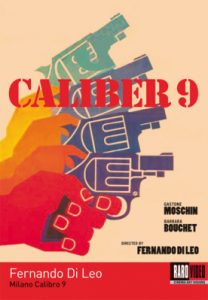 more precisely jammed inside small cars) and their star power really delivers the punch, slap and roundhouse kick needed to bring moviegoers flocking to the cinema. Franco Nero, Tomas Milian, Luc Merenda, Fabio Testi among others removed more “garbage” from the streets than all the nation’s sanitation departments combined.
more precisely jammed inside small cars) and their star power really delivers the punch, slap and roundhouse kick needed to bring moviegoers flocking to the cinema. Franco Nero, Tomas Milian, Luc Merenda, Fabio Testi among others removed more “garbage” from the streets than all the nation’s sanitation departments combined.
Available from Kanopy are a handful of poliziotteschi released by the excellent film distributor Kino Lorber. They include several movies by Fernando di Leo, generally considered to be the maestro of the genre. His Milieu Trilogy is considered a high-water mark of the genre and is a great starting off point – Caliber 9, The Italian Connection and The Boss. Volume one in the trilogy, Caliber 9 was the first poliziotteschi I ever saw. The opening scene sets the tone for every bit of Euro-crime insanity that followed in the subsequent films I’ve seen. Before the credits roll even, the first five seconds (!!) introduces a suitcase full of money. Then through a montage with practically no dialogue (but some aforementioned funky flute) there is a whack of panicky double-crossing and revenge going down as the money goes missing. By the end of the first five minutes, three culprits are quickly dispatched – tied up together in a cave outside of Milan and a bundle of lit dynamite sticks (the kind you see in Looney Tunes) is thrown at them exploding both the patsies and the cave. What an intro! I mean who among us would even know where to find a cave on such short notice for a quick payback?
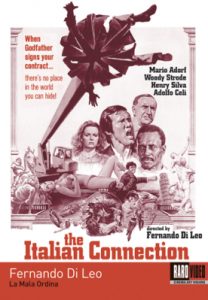

Di Leo followed Caliber 9 up with The Italian Connection which also does not waste time out of the gate. Within 10 seconds (again before the credits) the first line of dialogue spoken to two American hitmen (one black, one white who were the inspiration for Quinten Tarantino’s characters Vincent Vega and Jules Winfield in Pulp Fiction) is “The man to be killed is a certain Luca Canali.” And for the next 90 minutes we’re off the races.
Another good starting off point is Kidnapped by Mario Bava – a departure for the godfather of Italian horror – which is a little different than most of the films considered to be poliziotteschi. Well worth a view.
There are times when you can’t judge a movie by its title. This is definitely not one of those times. Other garish and gaudy gems to be found on Kanopy are:
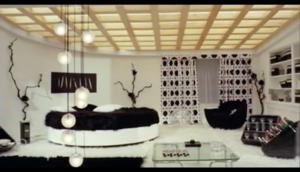
I believe this is called Pleasure Palace Chic – bedroom set from Caliber 9 © Kino Lorber
Young, Violent and Dangerous
Meet him and Die
Kidnap Syndicate
Shoot First, Die Later!
Naked Violence
Live Like a Cop, Die Like a Man
And several other Italian films distributed by Rarovideo available to borrow on dvd and blu ray when the library re-opens.
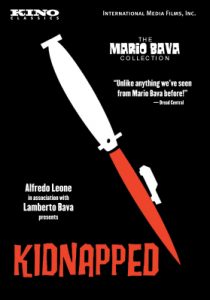
Retrospective screenings of poliziotteschi in repertory theaters and scholarly articles in highbrow reviews demonstrate a new found appreciation of the films, showing they are something more than just trashy thrillers (although they are that too) I find that any discussion of these sorts of films in more contemporary times generally comes with a disclaimer – some mention of the elephant in the room. That being the fact that these films don’t age well in some ways (and I’m not talking about fashion and interior decor although it’s true there as well – you’ve never seen so much overstuffed upholstery, sunken living rooms and wall to wall carpet). This quote about poliziotteschi by Phil Nobile Jr. from the website Birth.Movies.Death says it better than I ever could
“They’re violent, and sexist, and all sorts of inappropriate, very often too brutal for casual viewers. And they are, in the truest sense, foreign films: the way the characters behave is often at odds with 2015 America, the films are visually unconventional, and they are not crowd pleasers in any contemporary sense of the phrase. But if you’re able to recalibrate your brain to a certain frequency, and if you’re able to understand that neither depiction nor ingestion equals endorsement, there are ample rewards to be found in this genre.”
To be honest, the faults aside, I find I slide very comfortably into the world of older movies – not just the sort I’ve written about here. They take place in a world that barely exists anymore. A world of typewriters, rotary phones, reel to reel film projectors, transistor radios, payphones, daily newspapers and of course old school dynamite plungers. It’s all oddly comforting.
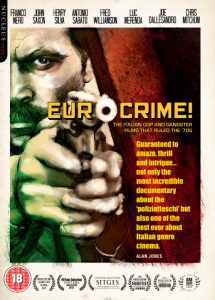
I kept this final bit of poliziotteschi promotion until the last because I didn’t want anyone to skip reading and head over to Hoopla or stay on Kanopy to borrow the documentary Eurocrime! It’s so good both streaming services have it! It has everything you’d ever want to know about these movies (and hopefully proves it’s not only just my own totally bizarre niche interest -although I can’t rule out that possibility). While at Hoopla, try listening to a modern take on the crime film soundtrack Euro-Crime Remixes! by Calibro 35.
Now that your engines are all warmed up, put that foot on the accelerator and go crashing into the middle of poliziotteschi: a weird and wonderful moment in pop culture and film history.